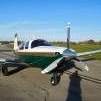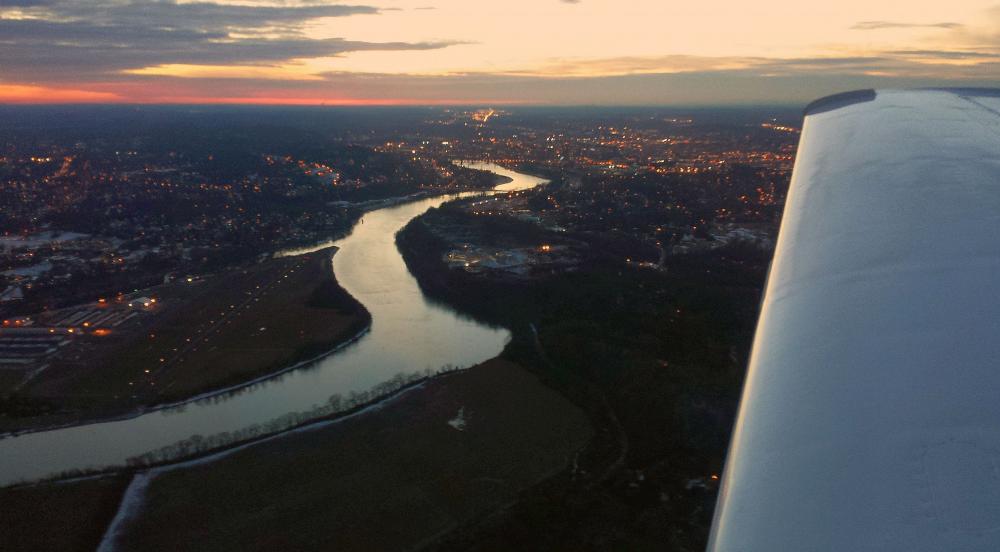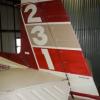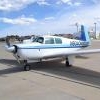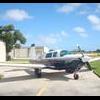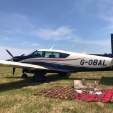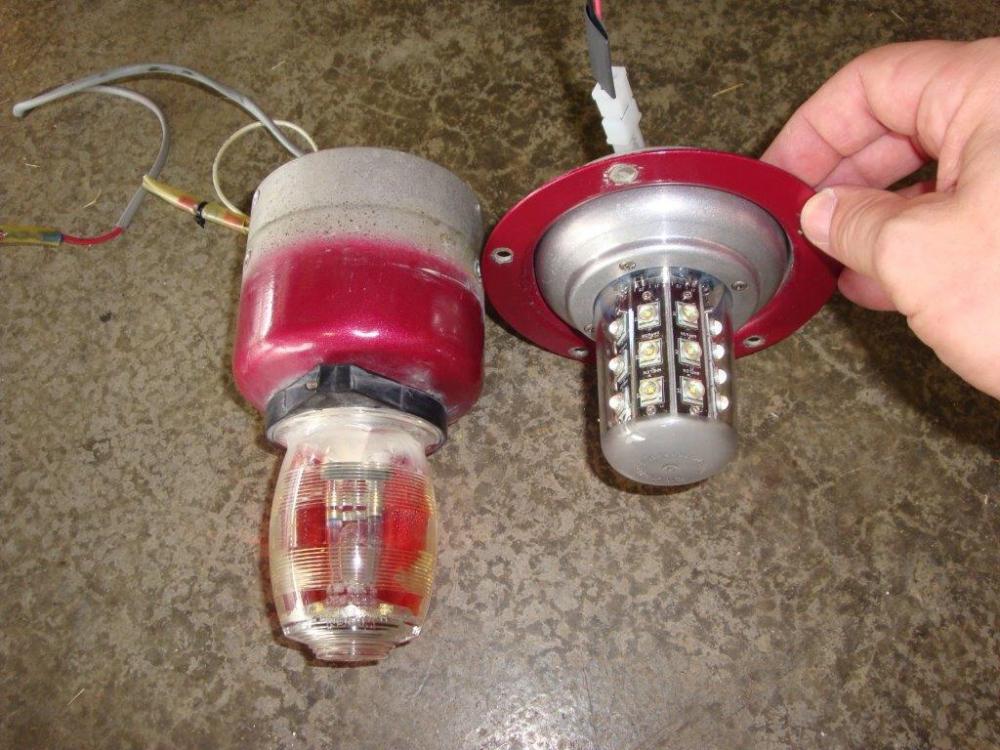Leaderboard
Popular Content
Showing content with the highest reputation on 01/14/2017 in all areas
-
DM, I made a tow from a used Hoveround electric wheel chair 6 years ago. I found the chair on Craigslist and gave $160 for it. I built a hitch (tongue) for it and installed a 2 1/2" ball on the foot rest of the chair. I attach the hitch to the plane with a round metal rod that extends completely through the nose wheel attach point. I'll post a picture or two. Sorry for the poor quality. By the way, the chair has plenty of power to tow the Mooney with me sitting on the chair. I can tow the plane nearly as fast as a person can walk if necessary. There is a slight learning curve to operate it. I'll have to admit, I get some very funny looks from people who see me moving my plane with a wheel chair! I also used to have a Challenger II Experimental. In order for me to hangar it in the same "T" hangar with the Mooney, I built a lift for it using a walk-behind forklift. I got the forklift on eBay for $480. I built a fork extension for the plane to sit on. I raised the Challenger about 6' and the Mooney fit under it without any problems. I used it for 3 years or so until I sold it along with the Challenger.5 points
-
Hello everyone, apologies for the delay in responding on this. this issue is related to higher vibrations levels in the plane, especially if it is mounted to a floating or shock mounted panel. in some of the cases these shocks have been found to be worn and replacing them is also an option to try and prevent this. remember this is a non TSO'd product and even though we did test it to some of these TSO levels it is not tested to some of these higher vibration levels. but the 2.6 software release was actually tested per some helicopter requirements and corrects most of these issues. let me know if there are any other questions,4 points
-
There is no replacement for displacement. That being said, you went on a single round trip flight, in one J model, with another pilot flying who may or may not know how to get the best out of his airplane. My observations would be the following: 1) If I owned a J model that trued at just 150kts at 7000ft, I would be investigating what the problem was. 150kts is the bottom of the barrel for a J model unless he was LOP in which case he should not have been burning 10GPH at 7000ft. That's where I flight plan my box stock geriatric F model and I often see more. 2) Getting the most out of an airplane requires planning. In a true XC situation, one would climb high to sip fuel with the best tail wind and return lower out of the strong winds. You seem to be implying that 11,000ft is "Ovation Country". A J model is extremely usable in the 10,000ft to 15,000ft range. Climb rate starts to drop off above 12,500ft but a good J should average more than 500FPM in a climb to 12,000ft. 3) The actual TAS difference between a well performing J and R at max cruise is about 25kts making the R about 15% faster in a race. The difference in fuel burn is about 5gph. This means that the R is burning about 50% more gas at max cruise. If you think that cross country block times will be 15% faster, I would bet that is highly optimistic even on longer trips, on short trips you get bragging right for landing a few minutes earlier and burning a lot more gas. Unfortunately, I would bet that block fuel burn will be 50% more for the R all other things being equal. 4) Useful load. I don't know the exact numbers for either specific plane, but both of the Rs I am familiar with weigh in at near 2400lbs with a useful of about 965lbs. I contrast that with my lowly 200hp F's dry weight of 1681lbs with a useful of 1059lbs. Let's compare a 500nm trip for a typical couple in both planes with 45min reserves. Using numbers for my F model pilot and spouse - 305lbs bags - 100lbs Fuel - 240lbs Aircraft dry weight 1681lbs Total payload and fuel 645lbs Total weight 2326lbs (note that loaded for the trip my plane is lighter than an empty R model). Power to weight ratio is .086hp for every lb. For a typical R Model pilot and spouse - 305lbs bags - 100lbs Fuel - 317lbs Aircraft dry weight 2395lbs. Total payload and fuel 722lbs Total weight 3117lbs Power to weight of .09hp per lb. Not really a huge power to weight ratio benefit for a normal XC mission. If the plane is being flown solo, then the P/W spread is greater, but you should understand that the 180 and 200hp machines do quite well when flown solo as well. Plenty of folks seeing initial climb rates of well over 1200fpm when flying solo in the cooler months of the year; great climb rates are not solely the purview of the big Conti's. I can often hold greater than 1000fpm all the way to 8000 in the cool months. 5) I'm not so sure that any long body has superior short field performance either in or out when compared to a 200hp mid or short bodied bird. Check your POH and compare. I believe that at gross weight as well as lightly loaded, the R is going to use more runway when compared to the lighter short and mid-bodies. My POH says a 200hp F will have a take off roll at MGW on a standard day of 880ft. Configured for the above mentioned 500nm XC trip the POH says 595ft at SL on a standard day. I am not trying to poo poo the big Conti-engined birds. I think they are great machines, especially if you fly alone a lot and don't care much about efficiency. I don't see them as the fire breathing muscle machines that some make them out to be. I think if one studies the performance specs, one finds an honest plane that goes somewhat faster on a lot more gas. With regard to the J model, I am trying to think of a certified, production 4 place aircraft that goes faster on a gallon of gas and nothing comes to mind...unless I include turbos. A good K model 252 will do better. In fact a 252 will hang with a standard Ovation above 10K and walk away from it above 15K...all while burning less gas. You might consider spending a bit more real world time in the J (maybe rent one if you can). I think you'll find that while the performance differences are significant, they're not quite as dramatic as you are portraying them to be.4 points
-
Published Vx is 80 mph in most early Mooneys. The climb is not seriously reduced by extended gear at that low speed. I suggest you not be in too great a hurry to get the gear up. Pitch angle & careful airspeed control are higher priorities in the first moments after rotation. My first dozen hours in my E model I seemed to need 600' to take off and 6000' to land. After a few hundred hours shorter field operations felt comfortable. A lightly loaded 200 hp Mooney, precisely flown, can operate out of quite short strips.3 points
-
Another vote for Jim and plane cover. Added the zipper option on my new cover, and I'm glad I did. Every time I put the cover on, I subsequently have to retrieve a stuffed animal or a child seat or a phone that slipped out of someone's pocket. And I do mean Every. Damn. Time. The zipper makes me less cranky about that.3 points
-
The electric wheel chair is genius! I'm surprised it has the power to move the airplane. Great idea. Lee3 points
-
With that smirk on your face, you're starting to look like the rest of us dirty old men.3 points
-
Last night was fun. It really is true that Mooney's attract the women. My girlfriend invited two of her friends to come to dinner with us. The two backseaters have never been in a plane before. I almost had to hit the intercom isolate button they were "oooohing" and "awwwwing" when I rotated, banked, and saw the sunset and moonrise. Flew over downtown Jacksonville, then swept down the beach down to Flagler. I made THE BEST LANDING IN MY LIFE. Nice cool air, ~60*F, absolutely no wind. Approach was ROCK solid. Transitioned to a "flare" and held it...held it...and just felt the tires start rolling. No screech, no plunk. Just perfect. The ladies thought that was normal! haha.3 points
-
2 points
-
First thing to check is to make sure the valve is shutting off. Push the lever in the cabin. Then open the panel on the plane and see if you can move the valve lever any further by hand. If the valve shuts off completely, and still loses pressure, it is the valve leaking. Only other choice would be a tank leak. (Extremely unlikely)2 points
-
The only "short field" procedure I use is at a nearby 2000' grass strip: stand on the brakes, full power, then release. Zoom through the bumpy grass, roast at 70 mph, positive rate--gear up. But I never go there heavy, my max is two people and half tanks. Other than that, I was based at an obstructed 3000' field for seven years. My normal,takeoff there was flaps up, brakes off, full throttle, rotate at 70 mph, positive rate--gear up. The trees at both ends obscured the numbers until short final, and I would often level off briefly to clear them before pulling power and descending to land; my typical touchdown was in the 3rd strip (of 13 on the runway). Gentle braking was enough to turn around and back taxi well before the other end. Since then, I've moved to a 5000' field which spoiled me for a couple of years, and now I'm back at a 3200' field with a full taxiway, a huge luxury compared to where I started (with none). Oh, for heavy departures (near gross), I lower flaps to Takeoff, rotate at 75 mph, positive rate--gear up, and raise the flaps when I'm looking down in the trees. A pointer for the new Mooney pilot: when you drop flaps, the nose goes down significantly. Expect the nose to lift when you raise them . . . So push on the yoke and adjust trim.2 points
-
Thanks for explaining some of the considerations that go into the "don't ask me why, beats me" comment in my post Of course, this is not exclusively a GPS thing. There are ILS OR LOC approaches with lower LOC minimums. Again, TERPS requirement are the issue, and sometimes the difference is due to terrain or obstacles on the missed. i still think the complexity of GPS is overemphasized. There is a bit of technophobia in some folks that hampers learning, but aside from that, I suspect many fledgling instrument students will disagree about how "easy" it is to understand "simpler" approach plates. Heck, some of us have never been able to master the can't-be-simpler-in-concept NDB. The bigger problem is we tell people it's really complicated, that they are bound to have trouble understanding it. That becomes a self-fulfilling prophesy, We do it throughout instrument training. We manage to poorly teach or overcomplicate procedures as basically simple as holding patterns or DME arcs and they continue to strike fear into some otherwise excellent instrument pilots. And, now we do it with GPS. SSDD. For those who learned on paper VORs in 100% hand flown aircraft that did not even have DME (like me), there is definitely going to be a learning curve moving to GPS or from round dials to glass or paper to tablet. But, to me at least, that's about effective training, not some intrinsic limitation in the technology.2 points
-
I saw Tom depart KIMT with the Lancair yesterday and was some kind of impressive! He also bought lunch which was priceless. A great guy flying a terrific stable of airplanes.2 points
-
2 points
-
I have about 1,000 hours behind a G500 and never seen any issues with them. They seem pretty robust and reliable so I really had high expectations going into the G5. I flew it again tonight and there were no issues. I'm going to upgrade to version 2.6 and I'll report back with my findings.2 points
-
Update rough engine....tried it all.. Inspected: fuel lines, gascolator / carb fuel line screens, mags, plugs / leads, muffler baffle blockage, compressions, intakes for leaks.... Turns out the card was running lean. Local shop suggested sending to Burlington, NC for evaluation. Confirmed running lean so I now have overhauled carb on the engine and is running great. FYI carb had accumulated 1000 hrs and was last overhauled in 2003. Thanks to all for help and suggestions. GHW2 points
-
Yooper I'm surprised you didn't get a 906 N-number. Were they all taken? I'm not sure if someone brought this up before but is that headliner edge (made with fuel hose) a temporary thing? It does add some true U.P. charm. Sent from my iPhone using Tapatalk2 points
-
Scary stuff Steve. I would have thought there would not be any bugs like this. I know the AHRS versions of these AIs are unique in both their presentation and sensitivity. I found it a bit challenging to use initially since the scale of the AHRS is different than the mechanical indicators I was accustomed to using. The biggest challenge was the degree of descent or climb. A 10 degree climb looks huge as compared to the mechanical indicator. Once I got comfortable with the display, I find it much easier to see minor attitude changes.2 points
-
And you should let them believe that they are always like that. When you have one that isn't perfect and they're in the plane you just say, "Sorry, every now and then I have one that's like that."2 points
-
I spoke with Whelen sales and engineering on this awhile back (several months ago), and again today about this (along with other topics, such as the 90033 red anti-collision light LED replacement). They confirmed they don't have anything active in the engineering pipeline for an LED replacement for the 70303 recognition light at this point, nor do they anticipate starting anything, as there simply isn't enough of a market. They speculated that Mooney would probably be reluctant to engage, citing commitments to more critical projects in the pipeline. Whelen did confirm the usage of the 14V light as the correct part for 28V airplanes, citing the presence of an in-line resistor, so the Mooney folks are correct, as the OP pointed out. Whelen confirmed that bulb cannot be replaced individually, as it is "welded" into the mirrored/curved frame surrounding it. The 70303 "pod" would need to ordered as a replacement. IMHO, given the high replacement cost and low level of functionality that small light delivers, it really appears to be less-important or necessary, especially since the Ovations light up like Christmas trees already. For those of us who have the Orion LED Nav lights, there may be more than enough lighting coverage to warrant leaving our recog. lights off all the time, but this is obviously a personal and safety-related decision. Maybe LoPresti or another vendor would like to take on the challenge of a replacement, if not already underway...??2 points
-
I'm off to a good year. With the headwind trip back from Florida and flight testing the Lancair, I already have almost 20 hours in this year (will be over that before today is done). I will fly 2 hours this AM to finish off my 40 hour test time in the Lancair, and will take my building partner and best friend for his first flight in the plane he must have close to 1,000 hours helping build (no passengers allowed during Phase One Testing). Here is the only picture I managed to take yesterday. I had the power pulled back to a measly 27.5 gallons an hour going into the wind, seeing 135 knots GS, and pushed it up to cruise power going down wind (winds howling pretty good out of the west yesterday). I just couldn't resist seeing what she would do with a tailwind. I heard center calling me out as VFR traffic (verified by my ADS-B too). I have to wonder what he thought seeing me at 133 knots west bound and almost 400 knots east bound? Tom2 points
-
Putting in some safety pilot time in our M20J the other evening gave me an unusual opportunity to snap a few pics. Sunset over Knoxville TN, with "Downtown Island" airport KDKX in the foreground lower left. Looking west down runway 26 with the Tennessee River bending around the airfield. East TN is a great place to fly.2 points
-
No pictures, and maybe a short write-up later, but went out last night with my CFI and just did pattern work. Last time I flew at night was over 5 months ago in my PPL training. It was good practice, and I'm one hour closer to finishing up the dual requirements for insurance. Another 3.8 to go and I can venture out on my own.2 points
-
I often try to get some real IFR time and practice when we have a low cloud deck. 600 to 800 foot ceiling with 10 miles visibility are the really good days. Today I was hoping for some practice, but had to cancel/delay it. The LPV minimums are 250 feet agl, 7/8 visibility. The airport has been reporting 200 foot ceiling and 1/2 mile all morning. I guess it is time for a project!1 point
-
The Shelby County Aviation Association is planning a trip to Gatlinburg the last weekend of this month to support tourism. There are a couple of Mooneys scheduled to make the trip (including mine). We would love to have more. http://www.wvtm13.com/article/local-pilots-plan-fly-out-to-promote-gatlinburg-tourism/8597257?src=app Sent from my iPhone using Tapatalk1 point
-
Yes it definitely helps quite a lot even for a few hours.1 point
-
No, we are in the mid 50's. I was just crossing my fingers for a good practice day. Just a bit too much IFR.1 point
-
1 point
-
Anthony, I tried Googling to find it as well as a MS search. Found the installation manual, but nothing in there about them either. Good idea on the trim. I will try it this afternoon when I am back out at the hangar (nice thing about living 5 minutes from the home drome). Thanks.1 point
-
Another benefit to Plane Covers--they're held on by wide straps with adjustable clips. Nothing is ever attached to the plane. With Bruse, you need to out snaps on your plane, then there are problems later with snaps on the cover.1 point
-
Yep, anytime you see a Mooney take off, anywhere... if it's a J-bar Mooney, you'll see the gear disappear almost immediately on breaking ground. But don't try it your first time. It will take a few cycles to get comfortable with that Johnson bar. The first time you swing it, it will be a bit like wrestling a snake in the cockpit. But after 10 times or so, it will almost swing its self and will be very easy. But if you wait until you're past 90 mph, it will probably be a two handed job. So earlier is better.1 point
-
You're correct! As is Anthony's statement. Additionally when the mixture is leaned past stoichiometric (peak) the flame front propagates slower. Now there are two factors (ignition timing and reduction in flame front speed) that are moving combustion event pressure not only away from TDC but likely cause a situation where a significant part of the combustion event is occurring after BDC where the exhaust stroke begins. Not efficient. Why did you have your ignition timing retarded to 20°?1 point
-
TJ, By starting the burn earlier, more fuel gets finished before it exits. More power, and higher CHTs are the result of moving the timing further before TDC... Ross gives the best explanation of this phenomena. Bonal, the TC'd engine gets a very different compression ratio, the Acclaim TN'd version gets a slightly different compression ratio. The materials are a flavor of the day. You can read about cylinder construction on the Continental web site. Best r guards, -a-1 point
-
probably yea. too much working against it to save a couple hundred bucks though. Never done the process so not sure what it takes. Weekend coming up and the govt wont be open anyway. The guy that is coming is going to hawaii next week so if I dont get him tomorrow it will be another week im down assuming i dont find somebody else. oh well im just bitching. Im thankful we didnt find anything major during the annual, and now my logbooks will be up to spec and I can keep better track of ADs. There were a couple tach changes over the years and the hours dont seem to match up well but thats sorted out now.1 point
-
When Trek posted this, Garmin hadn't described the problem with the FIS-B (ADS-B) Nexrad weather product in v14.xx and v15.xx of the GDU software. It is described in Garmin Service Advisory 1650, dated September 13, 2016 http://garmin.blogs.com/files/1650a.pdf. Here is the entire text of the Service Advisory: Service Advisory 1650: NEXRAD Data 13 SEPTEMBER 2016 AFFECTED PRODUCTS: Garmin GTX 345R Transponders interfaced to a G900X, G950, G1000, Cirrus PerspectiveTM, or Embraer ProdigyTM (with GDU software versions 14.00 through 14.04 and 15.00 through 15.12) are affected. DESCRIPTION: NEXRAD data is not available when PRECIP is selected. NOTE METARS/TAFs will continue to show on the display. Weather and precipitation data will also be available on a portable electronic device via Bluetooth with a Garmin Pilot subscription. PILOT ACTION: Rely on other sources for weather precipitation data. RESOLUTION: A future GDU software release will correct this issue. Note: The 0401.30 software runs GIA v5.60 and GDU v9.03. The 0401.34 software runs GIA v7.62 and GDU v14.02. So, with the 0401.30 software, TIS (ADS-B) traffic will display on the G1000. No ADS-B weather will be displayed on the G1000. XM weather (including Nexrad) is not affected and will display on the G1000. ADS-B weather and traffic will display on a tablet running Garmin Pilot or ForeFlight via Bluetooth. On non-WAAS G1000 Mooneys a GTX 345R installation will require the version with an internal WAAS GPS receiver and an additional WAAS GPS antenna. With the WAAS software, the GTX 345R without the internal GPS can be installed since it can get position source from the WAAS GIA 63W units. However, v14.02 of the GDU software precludes display of FIS-B Nexrad weather on the G1000. As above, XM weather does display on the G1000. According to Garmin's Zach Evans, the Mooney OEM Sales Manager, v15.20 of the GDU software resolves this issue. He said this version was made available to the OEMs in December, 2016. Edit: As Lance correctly notes below, Trek had posted today. I had recalled a similar post from Trek in February, 2016. My apologies.1 point
-
My jaw dropped when I saw that picture. Just imagine cruising along in IMC and suddenly seeing that. These units are billed as potential life savers yet the manufacturers response is "a fix is available in the latest version".1 point
-
1 point
-
1 point
-
I've stopped by the whelen, spruce, and wicks booths for 3 OSH airshows now. They are all the same price, and it's almost the same price as the spruce website. Strange coincidence.1 point
-
Went flying again Wednesday night and put another 1.9 in the logbook. Only another 1.9 of dual to go before I'm free and on my own. We went airport hopping, KAJO > KSBD > KEMT > KFUL > KAJO. Good times! http://intothesky.us/2017/01/11/pattern-work-and-airport-hopping-at-night/1 point
-
Whatever the bulb is, the original bulb will melt the plastic lens if there is no airflow past it. Meaning the recog lights need to be shut down right after landing... The cost of not following a check list is a few hundred bucks per side... It also serves as a reminder that a human brain can be distracted, similar to a GU landing... just a lot less expensive. Best regards, -a-1 point
-
1 point
-
Today we had a local school come on a field trip to the airport. Myself and a few others showed the kids the airplanes and the basics. We even had LifeFlight stop in to show the helicopter, a local RC pilot did a little airshow, and a powered paraglider did a few passes at 10mph. What a great day, I think my smile was bigger than theirs1 point
-
My Mooney Musings I've flown and taught in almost all the Mooney models extensively (over 8,600 hours of my 10,600 hour total). Once you've extensively flown the speed of the turbos you just don't want any less. I know all about LOP and just prefer to fly fast ROP. I don't particularly care about fuel flow, but I do care about fuel prices, so will plan my flights for minimum cost of fuel. I prefer to fly the mid teens for smoothness of the flight. I don't like masks, but don't mind the conserving nasal canulas at all. Under 10K, especially in Arizona and Wyoming leads to a bumpy ride in the summertime due to thermal turbulence. I prefer glass, just not the limitations Mooney has placed on the G1000, so I don't think I would ever buy a G1000 airplane. The Acclaim's extra speed isn't worth the extra money paid for the airplane, although if someone wants to buy one, I'll teach them how to fly it properly. If you fly an airplane the way it should be flown with grace and smoothness, you won't notice the difference in flight in control responsiveness between all models of Mooneys. The long bodies are heavier and give a smoother ride in turbulence. It does take some time to master their landings after flying the short body Mooneys. The turbo long bodies are more expensive to own so expect to always be fixing something on them, In fact expect to always be fixing something on ANY airplane you buy. Fuel burn on the long bodies are much greater than the short bodies. If you care about fuel burns, don't buy a long body. There is much more space in the long bodies, and useful loads can be increased if you remove the back seats. I usually fly with no back seats and have weight and balances for both configurations. There hasn't been one Mooney from the A Model to the TN that I have flown or taught in that I would rather have than my own. There is also no other single engine piston airplane that I would own other than a Mooney. Mooney Instructor and Bravo Owner for 24 years and counting.1 point
-
I'm not sure what your point is, thats like comparing an AMG Mercedes to a VW Golf are you just tying to make us slower Mooney pilots feel bad1 point
-
its kinda the same argument I have with the cherokee>>mooney C transition. It's not just the TAS, it's the GS when flying against a headwind. 120knots in a mooney vs 70-80 in a cherokee in a 30 knot HW. I'd love to have a 185 knot bird, but I'm so comfortable with my C and the costs associated with it.1 point
-
I designed and built the one shown here. Not really workable unless you can weld, etc. unless you con me into building one for you. I also have a riding mower I took the deck off of. The biggest problem is attaching a ball or other mechanism, and rigging a tow bar. I prefer my smaller one, so I don't have to get out the mower.1 point
-
I've asked my MSC to quote me for the standard WAAS Kit.. Since the WAAS kit was what we expected. 2 GIA's, antennas, manuals and that it works with the current general release -30 software. I expect that coupled LPV -> STEC would just be a software/certification project that they haven't done yet. GIA63's only have one set of horiz/vertical deviations outputs and the Stec one input.. so if the signal is being set for the LOC/GS.. the software just needs to send it for LPV.. but garmin made that coupling optional, and its use is probably based on OEM testing and certification. We should thank Mooney for releasing this, we were patient (10 years for some). We should also request general updates/timelines for the -34 general release and then the future ADSB -> GTX33ES software update. I would encourage the MooneySpace users to indicate that yearly software updates are expected in post sales support, as essential in today's market like being able to order parts for 40+ year old airframes. Is the consensus that only Cirrus and TBM are providing regular Garmin software updates?.. It seems that Cessna, Beech, Diamond and Mooney are lacking in this regard, and that keeps out sales of FlightStream, GDL88, TCAS, AOA and any other newer technologies. Every G1000 should be supporting the FS510.1 point
-
I'm an engineer and so I'm pretty good with numbers. But why bother. I can also shoot an approach with and ADF, but who wants to when the 540W and the Stec30 will do it for me. Meanwhile I watch and make sure they done screw it up. Why do all the math, with the possibility of human error when the little blinky lights make it so easy. It is the 21st century after all. I don't fly in ice! And if I was ever iced up, the AOA is the least of my worries. And I'm certainly not relying on it to get me into a short strip or monitor a tight base to final turn. I don't need the AOA or the ASI or anything but my butt in the seat to properly land on a 6000+ ft runway. I'm not a professional pilot, and don't have a copilot either. So I'll take the little AOA vane, in spite of the fact the FAA hasn't had the resources to certify it as a primary instrument, and be thankful for the help. Speaking of professional pilots, there are plenty I wouldn't let fly my Mooney no matter how many 73?? whatever's they have time in.1 point




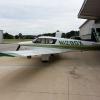
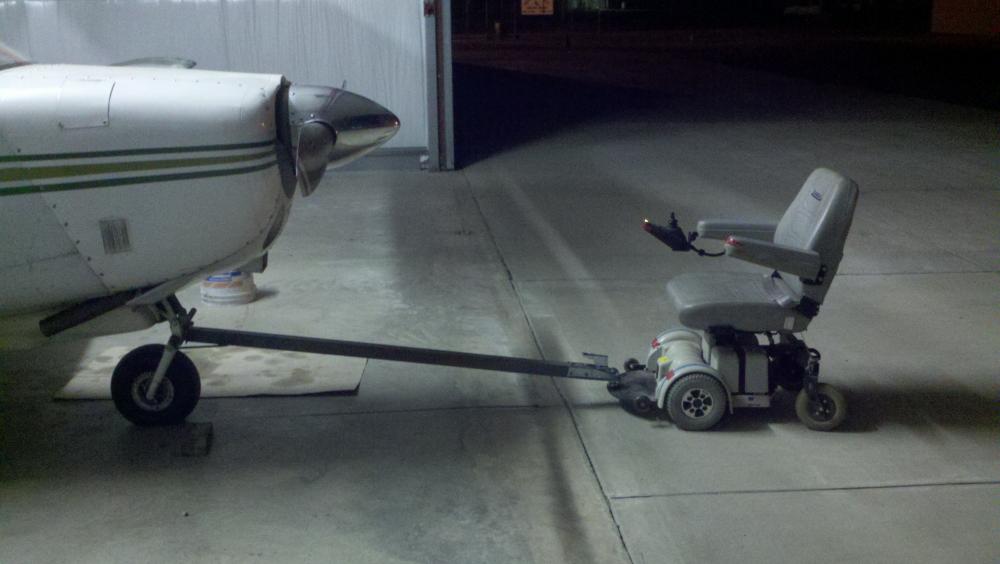

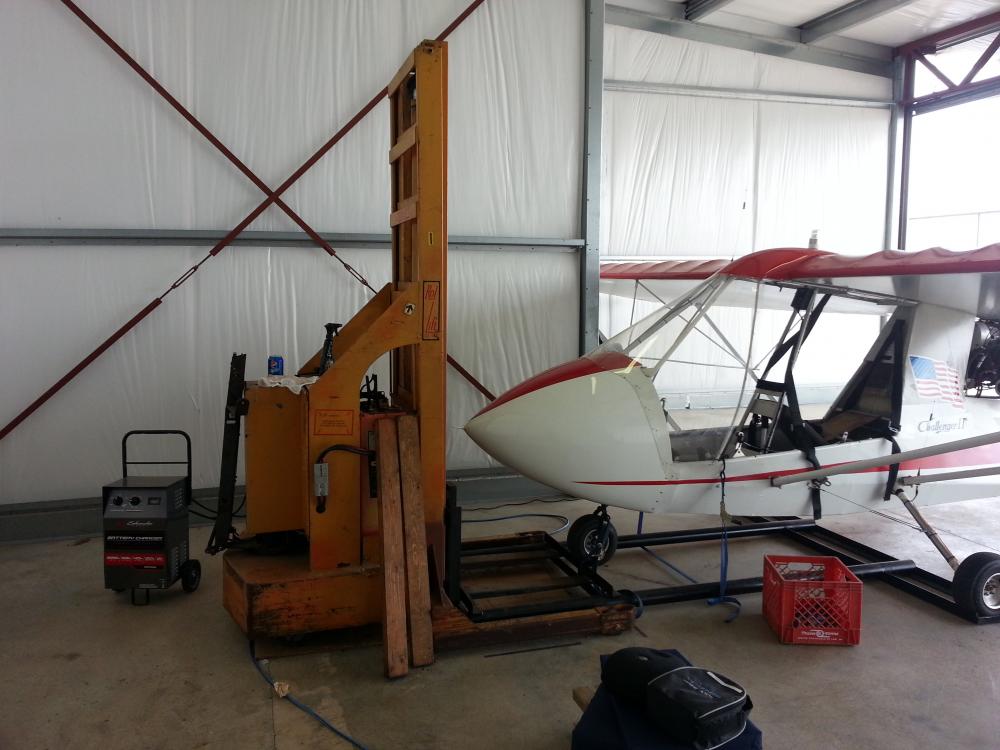

.thumb.jpg.3b7e6053543e5b3f345615b9eb4a086e.jpg)


.thumb.png.7c67574d7b28f67b0b4a17760919b1ac.png)





